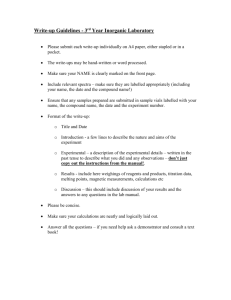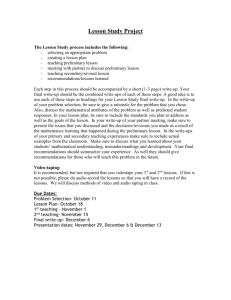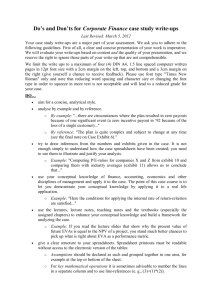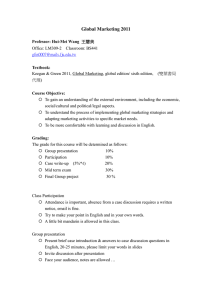THE UNIVERSITY OF NORTH CAROLINA AT GREENSBORO − MBA 625-11
advertisement
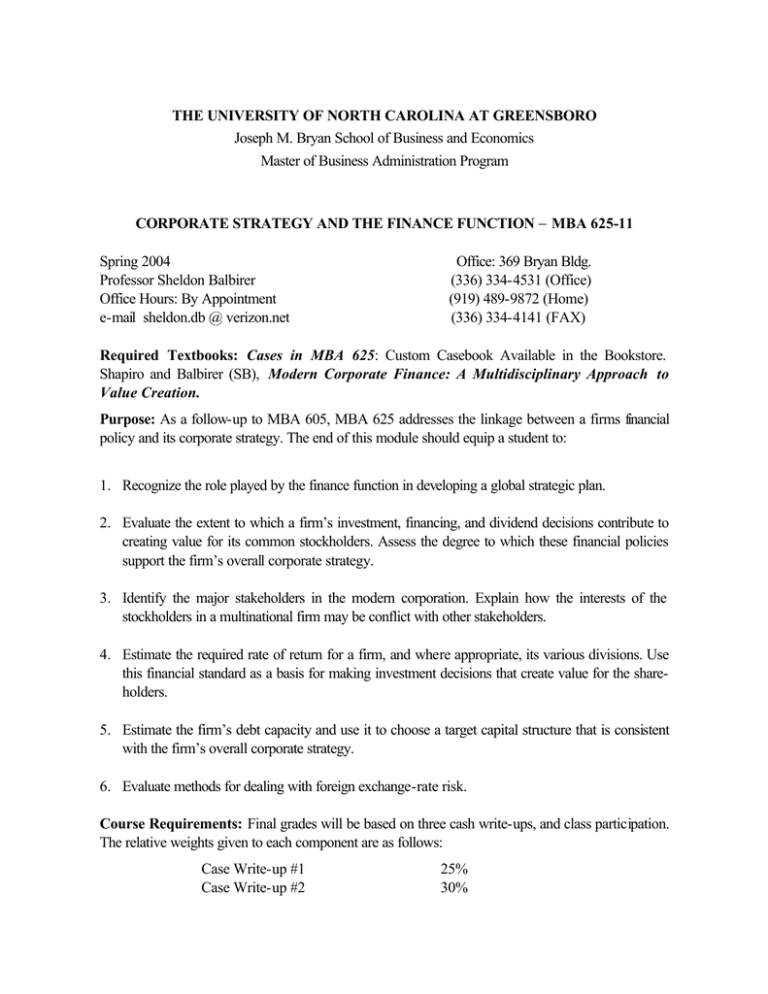
THE UNIVERSITY OF NORTH CAROLINA AT GREENSBORO Joseph M. Bryan School of Business and Economics Master of Business Administration Program CORPORATE STRATEGY AND THE FINANCE FUNCTION − MBA 625-11 Spring 2004 Professor Sheldon Balbirer Office Hours: By Appointment e-mail sheldon.db @ verizon.net Office: 369 Bryan Bldg. (336) 334-4531 (Office) (919) 489-9872 (Home) (336) 334-4141 (FAX) Required Textbooks: Cases in MBA 625: Custom Casebook Available in the Bookstore. Shapiro and Balbirer (SB), Modern Corporate Finance: A Multidisciplinary Approach to Value Creation. Purpose: As a follow-up to MBA 605, MBA 625 addresses the linkage between a firms financial policy and its corporate strategy. The end of this module should equip a student to: 1. Recognize the role played by the finance function in developing a global strategic plan. 2. Evaluate the extent to which a firm’s investment, financing, and dividend decisions contribute to creating value for its common stockholders. Assess the degree to which these financial policies support the firm’s overall corporate strategy. 3. Identify the major stakeholders in the modern corporation. Explain how the interests of the stockholders in a multinational firm may be conflict with other stakeholders. 4. Estimate the required rate of return for a firm, and where appropriate, its various divisions. Use this financial standard as a basis for making investment decisions that create value for the shareholders. 5. Estimate the firm’s debt capacity and use it to choose a target capital structure that is consistent with the firm’s overall corporate strategy. 6. Evaluate methods for dealing with foreign exchange-rate risk. Course Requirements: Final grades will be based on three cash write-ups, and class participation. The relative weights given to each component are as follows: Case Write-up #1 Case Write-up #2 25% 30% Case Write-up #3 Class Participation 35% 10% Write-ups should no more than five doubled-spaced typed pages, exclusive of exhibits. The write-up should be an individual effort that reflects both an understanding of (1) the decision/policy issues facing the firm, and (2) the alternatives available based on case data. Each paper must indicate clearly what the company should do. Computational work should be directed towards supporting your recommendation. To insure that students deal with both the investment and financing decision, at least one case must be turned in during the four weeks of the semester, and at least one case during the second four weeks. In additional to its technical aspects, the grade assigned to the case write-up will reflect how well you defend your point. In many cases, the financial analysis is simple compared to selling people on your recommendations within a specific organizational setting. Guidelines for preparing case write-ups are provided at the end of the syllabus. Please read it before turning in your first write-up. Since finance is not a spectator sport, daily preparation is necessary to obtain the maximum benefit from the course. To “encourage” your on-going involvement, 10% of your final grade will be determined by class participation. In the limit, students who simply turn in their written work and do not get involved at all in class discussions cannot to get an A. SESSION ASSIGNMENTS Session 1, March 22nd We’ll open MBA 625 with a discussion of the Walt Disney Productions (1984) case. The case is multifaceted and is designed to (1) show how corporate strategy influences valuation, (2) to motivate a discussion of what“ excellence” means from a financial viewpoint, and (3) how shareholders can evaluate corporate management. In dealing with the issues in the case, we will initially focus on the questions of corporate strategy. Then, we’ll take a “break” to solidify our understanding of the linkages between the required rate of return (a.k.a. the cost of capital) and value before returning to those segments of the case relating to valuation.1 For this session, try to answer the following questions: 1 Students who want to write-up the Disney case must deal with all of the issues in the case - not just those that are discussed on the first night. 2 1. What are Disney’s major business segments? What is the apparent business strategy in each of these segments? Are there any “red flags.”? 2. To what extent is global expansion part of Disney’s strategy? 3. Ron Miller, the CEO of Disney, said “We have created unique value along with competitive and strategic advantage.” What are the unique value and advantages to which he refers? For the latter part of the session, we will begin a discussion of the firm’s required rate of return and its role in making investment decisions. In preparation for this segment, read SB -Chapter 10, Sections 10.1 and 10.2. Session 2, March 29th For the opening segment of this session, we will use the Teletech case to explore the issues associated with the use of a single hurdle rate to evaluate all segments of a business versus a risk-adjusted hurdle rate system. There is also data in the case to give students some drill in calculating riskadjusted required rates of return. A procedure on how to calculate the required rate of return of a firm and its divisions can be found in SB – Chapter 10, Section 10.4. When you prepare the case, try to answer the questions below: 1. How does Teletech currently use its hurdle rate? Does this seem to be appropriate? 2. Estimate hurdle rates for each of Teletech’s business segments. What implications do these have for capital allocation? Assume a market risk premium (Rf– Rm) of 5.5 percent. 3. Should Teletech consider separate hurdle rates each of its division? What are the arguments for and against Conway going to a multiple hurdle rate system? 4. Is Helen Bruno correct right that management would destroy all value if all of the firm’s assets were redeployed to the telecommunication business segment? Why or why not? 5. What should Teletech say in response to Victor Yossarian? With our understanding of required rates of return, we can now deal with some of the valuation issues in the Disney case. Read SB-Chapter 11, Section 11.1. Pay particular attention to the concept of market-to-book ratio on pp. 350-351. Then consider the following questions: 1. From the data in case Exhibit 6, calculate the required return on Disney’s common stock for 1974-1983 using the capital asset pricing model (CAPM). Assume a market risk premium (i.e., 3 Rm – Rf) of 8%. How do these figures compare with Disney’s after-tax return on equity (ROE)? How would you interpret the differences? Note: If you need to jog your memory on the CAPM, consult Chapter 6 on Risk and Return. 2. Calculate the book value per share of Disney after making adjustments for the wide differences in current cost and estimated current value of certain assets such as (a) Disneyland, (b) the film library, and (c) the firm’s enormous holdings of raw land. How does this compare with the market price per share in late 1983? 3. Based on your calculations in (2), what’s Disney’s market-to-book ratio? Is Disney an “excellent” firm in financial terms? 4. As Disney’s CEO, would you buy back the firm’s shares from Saul Steinberg? Why? Why not? Session 3, April 5th To begin this session, we will consider some alternative approaches to valuing entire entities. Please read Appendix 11A on mergers and acquisitions. The background in this segment is critical in addressing the valuation issues in the Kennecott Copper. For the later half of the period we’ll look at the Euroland Foods, S.A. case. In January 2001, the senior management committee of this company has to decide which major projects should be funded for the coming year. The board of directors has set a limit of €120 million to be spent on capital projects for projects in 2001. Various managers, however, have proposed projects totaling €316 million. The task at had is to evaluate the discounted cash flow (DCF) analyses that the case presents, along with the qualitative factors (mainly strategic considerations and the internal politics of the company) and to choose the projects to be approved. 1. Be prepared to discuss the strengths and weaknesses of the various measures of investment attractiveness used by Euroland. Will all of the measures rank projects identically? Why, or why not? 2. Rank the ten proposals on the basis of purely economic consideration. Then rank them a second time based on any considerations you believe to be important. Are the rankings identical? Why or why not? 3. What projects should Euroland implement? Session 4, April 12th 4 In this session, In this session, we’ll look at two cases involving acquisitions in order to sharpen our skills in (1) calculating risk-adjusted required returns, and (2) valuing entities. The Kennecott Copper case deals with the proposed acquisition of Carborundum by Kennecott. In addition to allowing students to sharpen their skills on valuation, the case raises a large number of questions about the nature of governance in the modern corporation. One cannot fully comprehend the LBOs, hostile takeovers, etc. of the 1980s, as well as the current focus on shareholder value maximization, without some understanding of past conflicts of interest between managers and shareholders. Kennecott Copper provides this historical perspective. The following questions should guide your review of the case: 1. What potential economies or synergies are associated with the merger? How does it rate on considerations such as “strategic fit?” 2. Critically evaluate the methodology employed in the case to value the proposed acquisition of Carborundum by Kennecott. As part of analysis, review case Exhibit 7 carefully. Are the cash flows at the bottom of the exhibit free cash flows, or cash flows to equity? What rate are they being discounted at? What rate should they be discounted at? How should Kennecott’s proposed change in the capital structure of Carborundum influence the analysis? Note: To answer this question, it is essential that you calculate the risk-adjusted required return for Carborundum using the pure-play technique. The background material is in SB – Chapter 10, Section 10.3. 3. Is Carborundum worth $66 a share to Kennecott? If not, how much is it worth? As an outside director, how would you vote on the resolution to acquire Carborundum? 4. Review management’s decisions over the ten years of the case. Were the best interests of the stockholders served by these decisions? 5. Critically evaluate the motivation, performance, and role played by Kennecott’s board of directors, and its outside legal and investment banking expert advisors. We’ll close out the session with a look at the Super Project case. This case is chronologically old and deals with the introduction of an instant dessert by General Foods. However, the case is a classic in the sense that most of the issues raised are still relevant today. Specifically, students are asked to (1) identify the key assumptions needed to calculate the relevant cash flows from a project, (2) specify the relevant cash flows based on these assumptions, and (3) test the sensitivity of the projects returns to these assumptions. As you prepare the case, consider the following issue: 1. What are the relevant cash flows associated with the Super Project? In particular, how should management deal with issues like (a) test market expenses; (b) overhead expenses; (c) erosion of Jell-O contribution profits; (d) allocation of charges for the use of excess agglomerator capacity. 5 2. What is your feeling about the General Foods use of return on funds employed (ROFE) and payback as measures of investment attractiveness? If you don’t like these measures, what measure(s) should be used? Why? 3. How attractive is the Super Project in strategic and competitive terms? What potential risks and benefits does General Foods incur in either accepting or rejecting the project? 4. Should General Foods proceed with the Super Project? Why or why not? Note: To help in making this decision, you must calculate Super’s net present value (NPV). This means that you must also estimate General Food’s WACC. There is enough data in the case to make this calculation. Session 5, April 19th As we indicated in Session 1, the firm’s target capital structure is an important element in determining its required rate of return. This linkage between the investment and financing decision makes the determination of a target capital structure a critical element in the implementation of corporate strategy. In the first part of this session, we’ll deal with the question of how a firm should select its target capital structure. Please read the chapter on capital structure in SB – Chapter 14 since it will serve as a basis for our discussion. In the second part of our class period, we’ll use the Continental Carriers case to deal with the tactical decision of how a firm might go about raising funds in a given year. Continental Carriers is not a candidate for case wrote-up and will be used solely to illustrate techniques and issues. As you prepare this case, consider the following questions: 1. Consider the EBIT chart in the case. What information does it provide? What inferences can we draw from it? 2. Which of the financing alternatives is best for the stockholder? What are the impact of each alternative on earnings per share, earnings per share volatility, and the ability of Continental to pay dividends? 3. What should Continental do? Session 6, April 19th As an introduction to capital structure policy, the Du Pont case focuses on the practical issues confronting a firm in determining its debt policy. In reading the case, consider the following issues/questions: 6 1. Review case Exhibit 6. How much external financing will Du Pont have to raise in the near future? From a strategic perspective, what’s driving the need for external financing? 2. How does Du Pont’s acquisition of Conoco effect the risk of the firm? 3. How and why did Du Pont keep its AAA bond rating in 1975? Why did Du Pont lose its AAA rating in 1981? 4. Examine the data in case Exhibit 7. What, if anything, does it tell us about the relationship between bond ratings and interest rates? Are there any other “goodies” imbedded in the exhibit that might be of interest to Du Pont’s chief financial officer? 5. Compare and contrast the two debt policies in case Exhibit 8 for 1987. What bond rating would Du Pont receive under each alternative? How would its financial performance, access to the capital markets, and financial risk differ under the two alternative debt policies? 6. What target capital structure should the firm adopt? The Tonka Corporation case presents the financial and strategic positions of the sixth largest toy company as of 1987. At that time the company carried no debt on its balance sheet in sharp contrast to other major toy manufacturers. Based on financial and strategic considerations, students are challenged to recommend a capital structure policy for the firm. As you prepare the case, consider the following questions/issues: 1. How much business risk does Tonka face? 2. How much potential value, if any, can Tonka create for shareholders at each of the proposed levels of debt? How would leveraging up effect the firm’s taxes? 3. How much financial risk does Tonka face at each of the proposed levels of debt in case Exhibit 12? How would the capital markets react to a decision by the company to increase the use of debt in their capital structure? 4. What target capital structure would you recommend? What argument (s) would you advance to persuade the firm to adopt your recommendations? Your instructor will provide copies of the Tonka case in class. Session 7, May 3rd 7 We’ll begin the session with a consideration of High-Tech Running Shoes. The case deals with the tactical decision on whether to issue debt, preferred or common stock to finance a $50 million expansion program. As you prepare this case, consider the following questions/issues: 1. Examine case Exhibit 2. What does it tell you? 2. Do an analysis of uncommitted earnings per share for each of the alternatives assuming an EBIT of $10 million. What does this tell you that you didn’t know before? 3. What should John Simms recommend to Hi-Tech’s board of directors? The Compania de Telephonos de Chile case addresses the problems of a rapidly growing company in an emerging market that is constrained by a small domestic capital market and is seeking access to international sources of funds. One specific topic covered is the costs and benefits of establishing an American Depository Receipts (ADR) program. As you prepare the case, consider the following questions: 1. Was Compania de Telephonos de Chile (CTC) helped or hindered by the Bond Group’s ownership after privatization? In light of the tempting offers by other interested buyers, did it make sense for Chile to have selected the Bond’s Group at the time of privatization? 2. What are CTC’s external financing needs over the next three years? The next seven? What are the viable sources of financing over the same period? NOTE: You should find case Exhibit 10 useful in preparing your forecast of funds needs. 3. How effectively can the U.S. ADR market meet CTC’s needs over the next three to five years? How attractive would CTC’s ADRs be for an American investor? 4. As an advisor to Mr. Garcia, what financing strategy would you propose for CTC? What would be your first step in implementing the strategy? Session 8, May 10th The Eastboro Machine Tools Corporation deals with a company that is trying to decide whether to reinstate its cash dividend and if so, by how much. Assume that you are Jennifer Campbell, the chief financial officer, and prepare a recommendation to the board of directors on what Eastboro should do. As you prepare your recommendation, consider the following questions: 1. Using case Exhibit 8, explain what happens to Eastboro’s financing needs and reserve borrowing policy if no dividends are paid versus pursuing a 40 percent payout policy. 8 2. Based on the finance literature (and case data), is there any connection between dividend payouts and stock prices? 3. What are the arguments for a zero dividend payout versus a 40 percent payout? What do you think of the residual-payout-policy? Is it appropriate for Eastbor? 4. Should Olsen recommend the corporate-image advertising campaign and corporate name change to the directors? Do advertising and name change have any bearing on the firm’s dividend policy? 5. What recommendation should Christine Olsen make to Northboro’s board of directors? In the second half of this period, we will look at the management of foreign exchange-rate risk using the Dozier Industries case. The fact setting is straightforward; namely, that an American firm has recently learned that it won its first major international sales contract. The contract called for the installation of an internal security system for a firm in the United Kingdom at a price of £ 425,000. In accordance with the contract, the British firm had transferred £ 42,500 as a deposit, with the balance due upon project completion three months from now. The decision problem facing Dozier is whether to hedge the transaction and if so, how. As you prepare the case, consider the following questions: 1. Should Dozier hedge the transaction? If so, should it use the forward markets, or should it do a spot hedge? 2 2. Dozier submitted its bid on December 3, 1975. Should they have hedged at that point? How? 3. In general, how should foreign exchange considerations affect a firm’s strategy in bidding on international contracts? 2 To do a spot hedge, Dozier would borrow £ for three months. The £ received today can be converted into dollars at the current exchange rate and then invested short-term. Once the £382,500 were received from the contract in three months, the liability could be repaid. 9 GUIDELINES FOR CASE WRITE−UPS A question frequently asked in courses involving case write-ups is “what’s the instructor looking for”? While specifics are highly dependent on the nature of the case, most instructors have their “idiosyncrasies” relating to written cases. In the spirit of communicating expectations, here are some of mine: 1. All of the cases assigned require a decision and /or a specific set of policy recommendations. Your recommendation will invariably involve balancing a set of conflicting concerns. This is not a simple process, and your instructor is very sympathetic to the trauma that may accompany a thoughtful case analysis. However, the need to take a position is essential. Write-ups void of conclusions are unacceptable. 2. Your recommendations should come as early in the paper as possible, followed by the background and details of how you reached your conclusions. Don’t keep the reader in suspense; if your instructor wants mystery he’ll read Agatha Christie. 3. Your paper should communicate a sense of literacy. It is difficult for a reader to take your policy recommendations seriously if the write-up contains poor grammar, typos, and/or lacks a professional look. 4. A useful format is to assume you are the assistant to the major decision-maker in the case, and to put your paper in memo form. This perspective allows you to limit discussion to the issues at hand without spending a great deal of time on background material that the reader already knows. 5. An important determinate of your grade will be the degree to which your conclusions or recommendations flow logically from your analysis. Your instructor is less concerned with “the answer” 10 than how you arrived at it. Internal inconsistencies (i.e. saying something in one part of your paper and then contradicting yourself later on) are not only “untidy” but can negate an otherwise sound analysis. 6. The central issues in most cases can be addressed in no more than 6 pages exclusive of exhibits. In this context, your instructor will not be impressed with bunches of computer-generated exhibits, graphs, etc., unless they are needed to support your position. Exhibits, tables, etc. that are never referred to in the body of a write-up represent an undergraduate-mentality that more-is-betterthan-less. This is graduate school and we don’t reward by the pound. More important, busy executives don’t have the time to wade through show-and-tell. 7. Be sensitive to your audience. Since all cases take place in an organizational context, convincing others that your recommendations are “right” is as important as being right. Avoid phrasing that is insulting or condescending, since this will put the reader on the defensive. Further, if you are addressing your report to the firm’s CEO or CFO, please assume that these individuals are familiar with the basics. For example, there is no real need to spend time telling a CFO how you calculated a current ratio, or to describe market segmentation to a CEO. 8. Unfamiliarity with institutional detail/terminology in the cases is no excuse for a faulty analysis. In practice, you would be expected to know this information and/or learn quickly. The index of your text is a good starting point to fill gaps. A call to your instructor to clarify technical points is also fair game. 9. It is generally not a good idea to raise questions that you cannot answer. The case decisionmakers are interested in answers, not more problems to add to their worry-box. Limit your discussion to those issues where there is sufficient data to provide defensible answers. Lists of “problems” beyond this point simply clutter your paper. The same thing can be said for introducing strategy alternatives that cannot be defended by case data. 10. Finally, each case is accompanied by a set of questions that are designed to stimulate your thinking about the issues facing the firm’s management. They are not intended as a “punch list” to be answered 1,2, ….., etc. Instead, they should be integrated into the write-up as you see fit. Case write-ups that are nothing more than the answer to a set questions will be penalized by a full letter grade. 11

